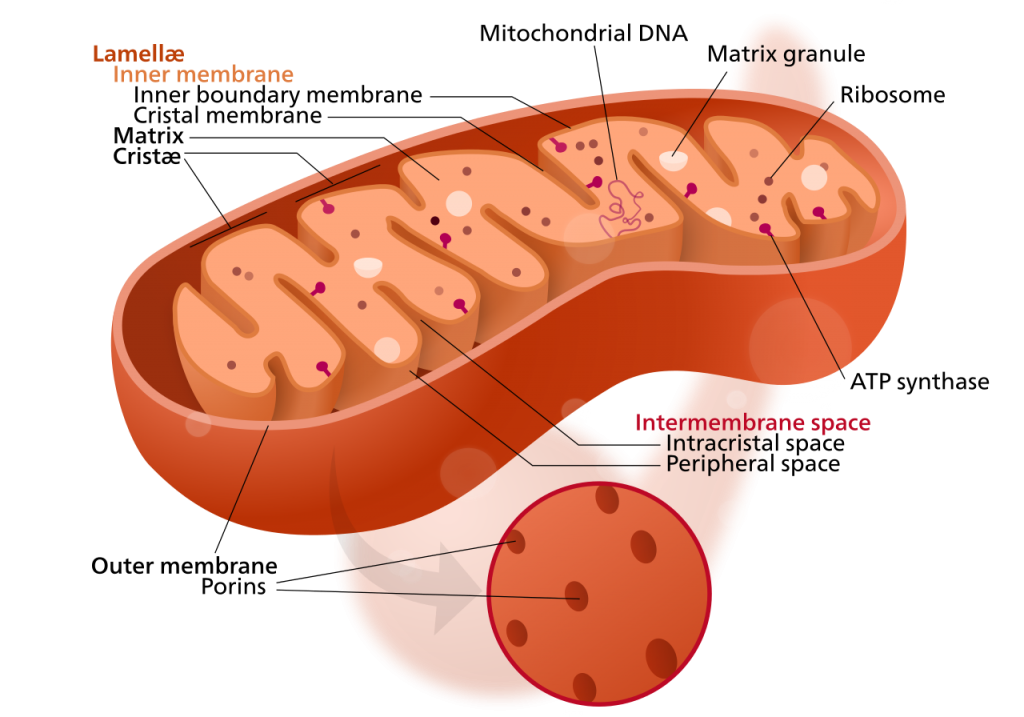Every organ in our body requires a constant supply of energy to function. Our brain and muscles, for instance, need energy to perform tasks such as thinking, walking, and running. The major energy generators in our cells are compartmentalized machines known as “mitochondria.” Mitochondria rely on a series of biochemical steps (collectively referred to as “cellular respiration”) to create ATP (adenosine triphosphate), which is used throughout the cell as a common currency for energy-dependent processes. Almost all cellular processes require ATP, making it a critical part of cellular health and survival.
When we eat, our food gets broken down into nutrients such as proteins, fats, and sugars. In the mitochondria, these nutrients are processed further to generate molecules of ATP. You may have heard mitochondria referred to “the powerhouses of the cell” for their role in producing ATP – because the cell uses energy nearly exclusively in the form of ATP, mitochondria are the major fuel source for our bodies. Some cells, like brain and muscle cells, require much more energy, and therefore contain many more mitochondria than cells that are less active. Additionally, the need for mitochondria can change in different parts of the body depending on energy demands. For example, a new exercise regime can change the number and activity of mitochondria in muscle cells.

Mitochondria are classically represented as oval-shaped, but that’s not always the case: they can have a shape anywhere from a long tube to a small sphere. Mitochondrial contents are held in by two separate layers or “membranes”. The inner membrane is dotted with several proteins that perform complex chemical reactions (known collectively as “oxidative phosphorylation”) to turn the broken-down nutrients of our food into ATP. An important feature of the inner membrane is that it folds into “cristae.” These cristae allow more membrane to be packed into less space. With a larger surface area, more reactions can occur simultaneously, thus increasing the efficiency of ATP production.
Why is mitochondrial function important?
When mitochondria do not function properly, energy production becomes faulty, and cells become starved for energy. Mitochondria are also involved in processes that regulate cell survival; sickly mitochondria, for instance, can send out a biological signal that promotes cell death. Because of the need for energy in every one of our cells, mitochondria are critical for many different functions throughout the body. As such, there are multiple types of conditions that can result from mitochondrial dysfunction. Symptoms between mitochondrial diseases vary, but can include muscle weakness, heart problems, liver problems, vision problems, and learning disabilities. Mitochondrial dysfunction is also involved in brain disorders such as Parkinson’s disease, Alzheimer’s disease, Huntington’s disease, and spinocerebellar ataxias (SCAs). Effective treatments for mitochondrial diseases still need further research; currently, physicians focus on using exercise and dietary supplements to promote ATP production and the formation of new mitochondria in patients with mitochondrial dysfunction.
If you would like to learn more about mitochondria, take a look at these resources by the Mitochondrial Biology Unit and London Health Science Centre.
Snapshot written by Dr. Claudia Hung and edited by Dr. Judit Perez Ortiz.










